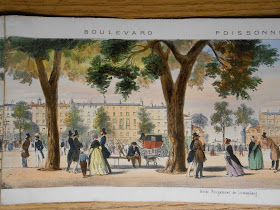 Until Louis Prang popularized chromolithography in the second half of the 19th century, printing in color was economically impractical. The few methods that had been invented were too difficult or expensive for regular use. Instead, printers would hire a team of colorists to hand-color images printed in black and white. Our Audubon double elephant folio on display in the reading room is one of the most famous examples, but we just bought an amazing hand-colored lithograph panorama of Paris that is stunning in its details, colors and brightness.
Until Louis Prang popularized chromolithography in the second half of the 19th century, printing in color was economically impractical. The few methods that had been invented were too difficult or expensive for regular use. Instead, printers would hire a team of colorists to hand-color images printed in black and white. Our Audubon double elephant folio on display in the reading room is one of the most famous examples, but we just bought an amazing hand-colored lithograph panorama of Paris that is stunning in its details, colors and brightness. This year, during finals week, we are offering students a chance to do some of their own hand coloring. We have scanned and printed some of our favorite black and white images from the rare book collections and put them out with some colored pencils for people to relax with. So, take a study break from November 16th to the 25th and come upstairs to the Galleries in Rauner to do come coloring! The books that the images come from will be on hold in the Reading Room all week (but you can't color in those!).
This year, during finals week, we are offering students a chance to do some of their own hand coloring. We have scanned and printed some of our favorite black and white images from the rare book collections and put them out with some colored pencils for people to relax with. So, take a study break from November 16th to the 25th and come upstairs to the Galleries in Rauner to do come coloring! The books that the images come from will be on hold in the Reading Room all week (but you can't color in those!).If you want inspiration, ask for the Panorama interieur de Paris (Paris: Ches Aubert, ca. 1840; Rare NE2439.25 P76 1843) or take a look at the Audubon in the display case.

